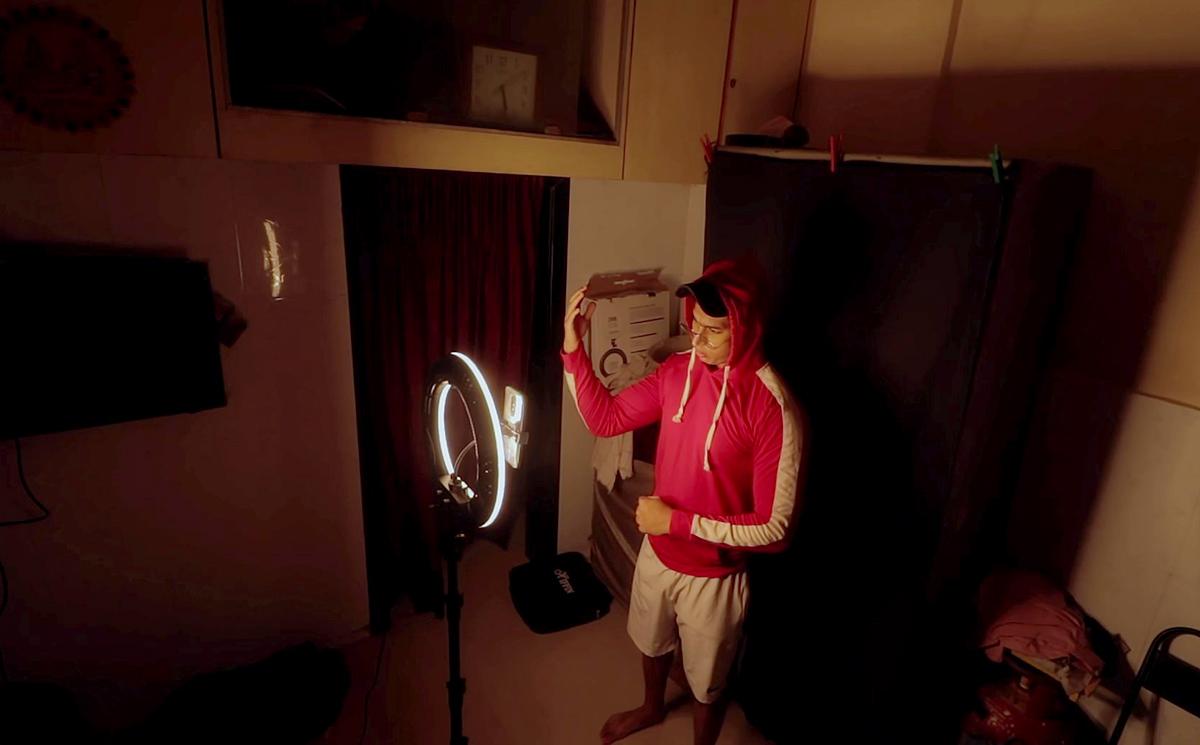[ad_1]
In India, TikTok unleashed creativity in people like never before until it was unceremoniously banned in June 2020, leaving them heartbroken.
IMAGE: A scene from 15 Seconds A Lifetime.
Mayur, a social media-savvy teenager, talks to his bestie about why he wants to sign up for TikTok, the short-form video app that gripped the world and formed its user base in millions, especially in India.
“There’s no point in thinking about earning money through this app so early, I just want to show my creativity,” avers the 19-year-old Mumbai boy, who envisions himself as a future TikTok star.
He is the protagonist of Director Divya Kharnare’s sublime documentary film, 15 Minutes A Lifetime, which focuses on one of the most influential platforms of the contemporary social media landscape and what it meant for people like Mayur.
Shining a torchlight on his journey, the director documents the different facets of the youngster’s dream over the course of eight months starting from November 2019.
In India, TikTok unleashed creativity in people like never before until it was unceremoniously banned in June 2020, leaving them heartbroken.
The 50-minute documentary gives a glimpse into India’s aspiring influencers and small-town creators, and how this mobile application became their creative expression.
While the focus of the subject is fixated upon Mayur and his dysfunctional middle-class Maharashtrian family — the ebullient mother, subdued father and waggish younger brother — the film gives an all-encompassing look at the craze this app brought upon the people.
We see a young man who left his job to become a full-time TikToker and working towards achieving 100K subscribers for himself.
There is someone who proudly claims that he spends 10 hours daily watching TikTok videos.
These people highlight mass hysteria for the app which cut across the language and class barrier.
IMAGE: A scene from 15 Seconds A Lifetime.
“I was amazed by the popularity of TikTok in our country and decided to make it the subject of my film,” says debutant film-maker Divya, now 23, as he addressed the audience post the screening.
“When I got to know that Mayur was planning to open his TikTok account, I saw it as a great opportunity to understand its craze up close. I persuaded him to let me document his journey for the initial three months. We then continued shooting for a whole eight months. His family became a part of it too.”
Divya Kharnare and Mayur were classmates studying at a media course at a Mumbai college.
They started this ‘project’ on a shoestring budget with a three-person team, Cannon 77D, and a Shotgun mic borrowed from Mayur himself.
The team managed to accumulate over 100 hours of footage and the post-production work went on for about a year.
In 2022, the film was officially selected for the New York Indian Film Festival and had its premiere there.

IMAGE: A scene from 15 Seconds A Lifetime.
But finding a suitable release and reaching the target audience was a challenge for Divya and team.
In a simple e-mail conversation, Divya convinced film-maker Hardik Mehta (Amdavad Ma Famous, Kaamyaab), who came on board as producer. Currently, the makers are running free screenings to maximise the film’s reach.
“It took me just one e-mail to get Hardik on board. I shared the trailer cut with him and he liked it. It was that easy. We are not making any money at the moment, but if at all we do in future, it would be fairly distributed amongst all of us,” says Divya.
On the surface, the film works as a coming-of-the-age story of the protagonist with many idiosyncrasies put on display.
In one particularly striking sequence, Mayur colours his hair platinum blonde on a whim to look hatke in his videos. He faces his mother’s wrath and snide remarks from his father’s social circle but remains unfazed because in his head, he is committed to his TikTok fandom (he has 70,000 followers!).
The film provides an intriguing picture of people’s obsession with TikTok and to what lengths they can go to come up with the best possible content.
But Divya is not judgmental about it.
In fact, he is empathetic.
The film becomes the critique of the snobbish attitude of some who would dismiss these videos as uninspired chaff.
“There is an upper-class gaze on to these TikTokers who think this is all rubbish. But the sheer creativity at display says otherwise,” he says.
Furthermore, the director brings something new with his take on TikTok as he nudges the controversies surrounding it and also makes a subtle but effective political commentary over the nature of its ban.
As the app disappears, a new reality seeps in.
The virtual world that Mayur once imagined for himself comes crashing down.
He sits in the park and feels emotionally numb.
He eventually picks up from where he left off.
His hair changes from shimmery silver to the usual black.
He settles on a 9-5 job to support his family.
His father appears to be happy and his mother at peace, blissfully unaware that their son’s shattered dream has given birth to life as we know it.
[ad_2]
Source link




![Alia Bhatt's post-pregnancy transformation WOWS netizens; fans say, 'After delivery she is glowing more' over her latest pics [VIEW HERE]](https://webjek.com/wp-content/uploads/2023/02/Alia-Bhatt-13-600x315.jpg)









